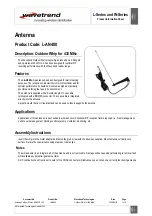
Tech Support:
www.steppir.com/support
Tel: 425.891.6134
Page 63
The DB42E Yagi offers high performance regardless of which band or direction the antenna is in. To do this,
at any given time each EHU functions as a Driven element. This is accomplished by using a single feed line,
and switching in and out each driven element using a relay. The coax switch housing is where the relays
and the relay board are located.
The installation of the coax switch box is not difficult, but as with all wiring functions, it is critical that you
take great care to ensure that the wiring is correct. Always make sure the electronic controller is completely
disconnected from the control cable and the power is off while doing any wiring. Locate the coax switch
mounting bracket (PN 10-1619-01). Use two 5/16” x 3-1/2” hex head bolt (PN 60-0065) and two 5/16” Ny-
lock nuts (PN 60-0046) to connect to the boom using two 2” aluminum saddle halves (PN 10-1601-22) as
shown in
figure 10.01
.
You should have already marked the location for the coax switch in
Chapter One
. Position the base portion
of the coax switch box onto the mounting plate. Line up the two holes located on the inside of the alumi-
num case with the holes in the mounting plate as shown in
figure 10.02
. Insert two #10 x 5/8” machine
screws (PN 60-01130) through the holes, Philips head positioned on top. Secure with two #10 Nylock nuts
(PN 60-0019) as shown in
figure 10.03
. A nut drive works well if you have one available. Be sure the coax
switch is level before tightening. Do not forget to use a set screw on the exposed portion of the aluminum
saddle.
Figure 10.04
shows the mounted coax switch base.
Locate the 4 conductor control cable, it will be a single piece, 2 ft in length. Trim the cable jacket off (about
1-1/2” will suffice) and remove the foil. Be careful when removing the cable jacket—too much pressure can
cause damage to the other wires. Trim the reinforcing thread so that you end up with a cable end that
looks like
figure 10.05
. Only three of the four wires are used, along with the shield wire. The green wire
needs to be trimmed as shown in
figure 10.06
. Use electrical tape to cover the end of the trimmed green
wire, to ensure that there is no opportunity for an electrical short to occur.
Figure 10.07
shows the complet-
ed control wire prep. It is not required, but you may want to tin the ends of the control cable, to prevent
fraying of the copper strands.
CHAPTER TEN
SECTION 10.0
COAX SWITCH HOUSING
MOUNTING THE COAX SWITCH HOUSING ASSEMBLY
FIG. 10.06
FIG. 10.05
FIG. 10.07
FIG. 10.01
FIG. 10.03
FIG. 10.02
FIG. 10.04














































